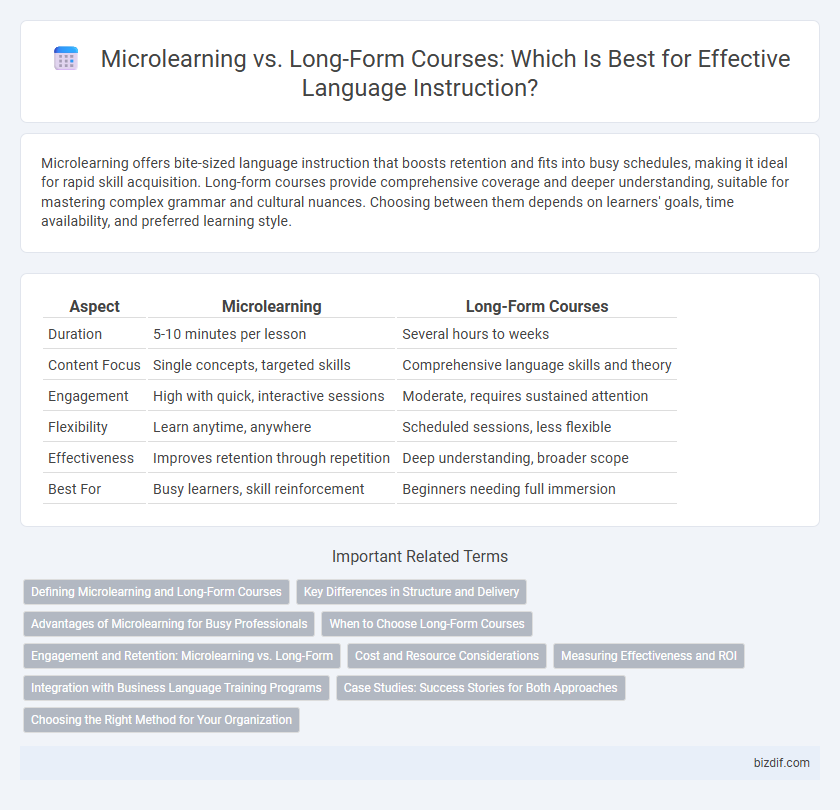Microlearning offers bite-sized language instruction that boosts retention and fits into busy schedules, making it ideal for rapid skill acquisition. Long-form courses provide comprehensive coverage and deeper understanding, suitable for mastering complex grammar and cultural nuances. Choosing between them depends on learners' goals, time availability, and preferred learning style.
Table of Comparison
| Aspect | Microlearning | Long-Form Courses |
|---|---|---|
| Duration | 5-10 minutes per lesson | Several hours to weeks |
| Content Focus | Single concepts, targeted skills | Comprehensive language skills and theory |
| Engagement | High with quick, interactive sessions | Moderate, requires sustained attention |
| Flexibility | Learn anytime, anywhere | Scheduled sessions, less flexible |
| Effectiveness | Improves retention through repetition | Deep understanding, broader scope |
| Best For | Busy learners, skill reinforcement | Beginners needing full immersion |
Defining Microlearning and Long-Form Courses
Microlearning involves delivering language instruction in brief, focused bursts, typically lasting 5 to 10 minutes, targeting specific skills or vocabulary to enhance retention and engagement. Long-form courses encompass comprehensive, structured language programs that span several weeks or months, covering extensive grammar, vocabulary, and cultural contexts in detail. These formats cater to different learning preferences, with microlearning emphasizing flexibility and repeatability while long-form courses offer in-depth mastery and systematic progression.
Key Differences in Structure and Delivery
Microlearning delivers focused, bite-sized lessons typically lasting 3 to 7 minutes, designed for quick knowledge absorption and high retention through repetition. Long-form courses involve extended sessions, often spanning weeks or months, featuring comprehensive content with in-depth explanations, extensive practice, and assessments. The structural difference lies in microlearning's modular, on-demand format versus long-form courses' sequential, curriculum-based delivery, catering respectively to immediate skill application and thorough mastery.
Advantages of Microlearning for Busy Professionals
Microlearning offers busy professionals flexible, bite-sized lessons that fit seamlessly into tight schedules, promoting better retention through focused, goal-oriented content. It enables immediate application of language skills in real-world scenarios, enhancing practical communication without overwhelming cognitive load. Short modules delivered via mobile platforms ensure consistent progress, making language acquisition efficient and adaptable to daily demands.
When to Choose Long-Form Courses
Long-form language courses are ideal for learners seeking comprehensive grammar, vocabulary, and cultural context in a structured timeline. These courses provide in-depth practice opportunities and allow for progressive skill development, essential for achieving fluency. Opt for long-form instruction when consistent, immersive exposure and systematic progression are critical to mastering complex language concepts.
Engagement and Retention: Microlearning vs. Long-Form
Microlearning enhances engagement by delivering concise, focused language instruction that fits limited attention spans, boosting immediate retention and practical application. Long-form courses provide comprehensive linguistic frameworks, enabling deeper understanding and cumulative knowledge but may risk learner fatigue and lower consistent participation. Balancing microlearning with strategic long-form content optimizes both engagement and retention in language acquisition.
Cost and Resource Considerations
Microlearning reduces costs by requiring shorter development times and fewer resources compared to long-form courses, which demand extensive content creation and ongoing maintenance. Organizations benefit from microlearning's scalability and lower investment in technology and instructor hours, making it ideal for budget-conscious training programs. Long-form courses, while offering comprehensive coverage, often incur higher expenses due to increased production complexity and resource allocation.
Measuring Effectiveness and ROI
Microlearning enhances language retention through targeted, bite-sized lessons that increase learner engagement and enable frequent knowledge reinforcement, leading to a measurable boost in skill acquisition efficiency. Long-form courses offer comprehensive language instruction, suitable for deep contextual understanding but often result in higher development costs and longer completion times, impacting return on investment. Evaluating effectiveness and ROI involves analyzing learner progress metrics, completion rates, and cost-per-outcome comparisons, with microlearning typically providing greater scalability and quicker payback in corporate language training programs.
Integration with Business Language Training Programs
Microlearning modules seamlessly integrate into business language training programs by delivering targeted, bite-sized lessons that enhance retention and allow employees to practice specific skills during work hours. Long-form courses provide comprehensive language instruction ideal for foundational fluency but require extended time commitments that may disrupt workflow. Combining microlearning's flexibility with long-form depth creates an optimal blended approach for effective corporate language acquisition.
Case Studies: Success Stories for Both Approaches
Case studies demonstrate that microlearning enhances language retention by delivering concise, focused lessons that fit busy schedules, with platforms like Duolingo showing significant user engagement and progress. Long-form courses, exemplified by institutions such as the Goethe-Institut and Alliance Francaise, provide comprehensive grammar and cultural immersion, leading to deep proficiency and certifications recognized globally. Both approaches yield successful outcomes, with microlearning excelling in consistent daily practice and long-form courses in structured, in-depth mastery.
Choosing the Right Method for Your Organization
Microlearning delivers targeted language instruction through short, focused modules that boost retention and engagement, ideal for organizations seeking quick skill acquisition with minimal downtime. Long-form courses offer comprehensive language training with in-depth content and structured progression, best suited for organizations aiming for thorough proficiency and mastery over time. Selecting the right method depends on factors like employee availability, learning objectives, and required language competency levels.
Microlearning vs Long-Form Courses Infographic

 bizdif.com
bizdif.com